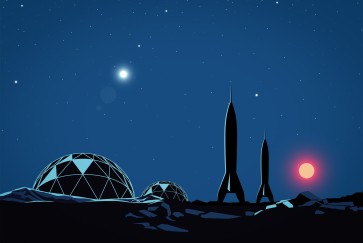Threats and coordinated acts of violence directed at legislators, poll workers and their families following the 2020 election leading up to the Jan. 6 attack on the Capitol, have continued into the 2022 midterm election cycle.
Throughout this period, media, cultural organizations and even law enforcement have turned to Kathleen Belew, an expert on domestic terrorism and the white power movement for insight.
Belew joined Northwestern’s history department this fall where she will work with colleagues to build a “History of the Present” initiative and teach courses in American history and the history of violence.
Since the publication of her book “Bring the War Home: The White Power Movement and Paramilitary America,” Belew has been a sought-after expert appearing on “The Rachel Maddow Show,” “AC 360 with Anderson Cooper,” “Frontline,” “Fresh Air” and “All Things Considered” among other media outlets.
The book was at the printer when the Unite the Right rally erupted in August 2017, and its timely publication provided historical context for the deadly violence and state of emergency that ensued in Charlottesville when a white supremacist drove his car into a crowd of counter protestors at the rally.
Belew spoke with Northwestern Now about the work of historians, her hopes of building a new “History of the Present” initiative at Northwestern and protecting democracy.
How did you get into this area of study?
As a graduate student, I wanted to understand the causes of racist violence in the U.S., so I began researching the history of the KKK and other white supremacy groups. A 2005 report by the Greensboro, North Carolina Truth Commission yielded an important insight.
The committee investigated the killings of five activists (four white presenting men; one Black woman) in 1979 by neo-Nazi and Klan members who were exonerated despite the event being caught on tape.
Jury members told the Truth Commission they voted to exonerate because if they [veterans] had killed communism in Vietnam, why wouldn’t they kill communists in the United States?
That to me represents such a profound collapse of battlefront and homefront, of war time and peace time, and lumps together all kinds of people as a “killable enemy.” I couldn’t stop thinking about it.
Do historians have an advantage over law enforcement in recognizing patterns of extreme violence?
What you get as a historian, is not just what people say they believe, but what they are actually doing over time. And then you get the records from the surveillance folks that have been declassified over time.
A lot of time, the Bureau of Alcohol, Tobacco and Firearms, the FBI and the CIA each have one little piece of the puzzle but don’t have the context to put it all together. In the pre-internet era especially, I think it was legitimately hard for anybody to connect the dots.
What unites extremist groups?
Klan history gives us a record back to the Civil War. Looking at archival materials left behind by the white power movement, the thread of anti-enemy violence carried all the way forward to the Oklahoma City bombing in 1995.
The archival record also shows what a wide-ranging and deeply set movement it is with a presence not just in the South, but in the southern California suburbs and in the rural Northwest and a bunch of big cities.
People in Evanston know better than to think racism is confined to the South because the Race Against Hate commemorates an act of violence carried out by the same movement. This impacts our community over and over. Anybody who has been following the events in Skokie and in Highland Park knows this.
What is the movement’s end goal?
In “Bring the War Home” the movement’s only route was asymmetric warfare to overthrow the government of the United States. That is still what a lot of people are interested in doing.
But now we also have this other course of action available which is anti-democratic politics. So, I think we now also must worry about attacks on institutions, attacks on our democracy and quite frankly fascism and authoritarian rule.
“Yikes” is the headline.
How can studying history help society address the problem of violent extremism?
Studying this history gives us more tools for how to combat the problem.
Charlottesville had a successful multimillion dollar lawsuit against the groups that came in and marched with tiki torches. If you go to Hayden Lake, Idaho, the epicenter of white power activity in the ’80s, there are people who live in these communities who do not want these groups anywhere near their town. At one point, there was a series of lawsuits that tried to seize the Aryan Nations compound and turn it into a Peace Park. The recent arrest of a bunch of people in paramilitary garb on the way to a Pride Parade happened in the Hayden Lake community.
Is there a connection to mass shootings?
One of the other things we can learn from this history is to see “lone wolf terrorism” for what it is. Take the anti-Latino shooting in El Paso, the anti-Islamic shooting in Christ Church, the antisemitic shooting in Tree of Life Synagogue, the anti-Black shootings in Buffalo and Charleston. If we look at the history of the white power movement, those are all communities that are being impacted by the same types of violence. Those are all white power gunmen.
That means all those communities have a reason to come together and to face down this threat. Not all communities have the same kinds of resources. But together they are stronger than they are individually.
What is the history of the present?
I am delighted to work at Northwestern, where we are training journalists through Medill. One of the things I’ve learned during the press cycle of “Bring the War Home” is the importance of figuring out how to bridge the divide between history and journalism.
History of the present as a method is about figuring out how to tell stories about the very recent past in ways that are not just a road map of where we are and how did we get here – although that is part of it – it is also thinking about the ways that history might reveal contingencies, roads not taken and courses of action that might not have been visible otherwise. So, expanding the realm of what’s possible by looking at history.
When we open our Twitter feed and see the firehose of impossible information, history can help you slow down and understand what you are seeing.


